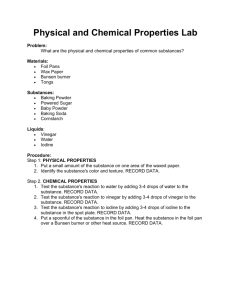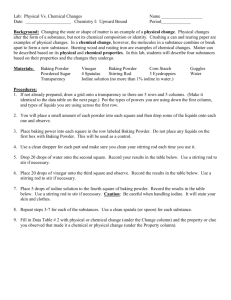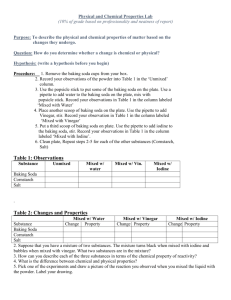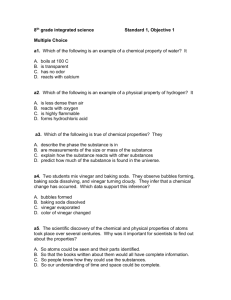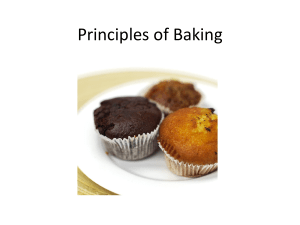Classifying Substances Lab: Chemical & Physical Changes
advertisement
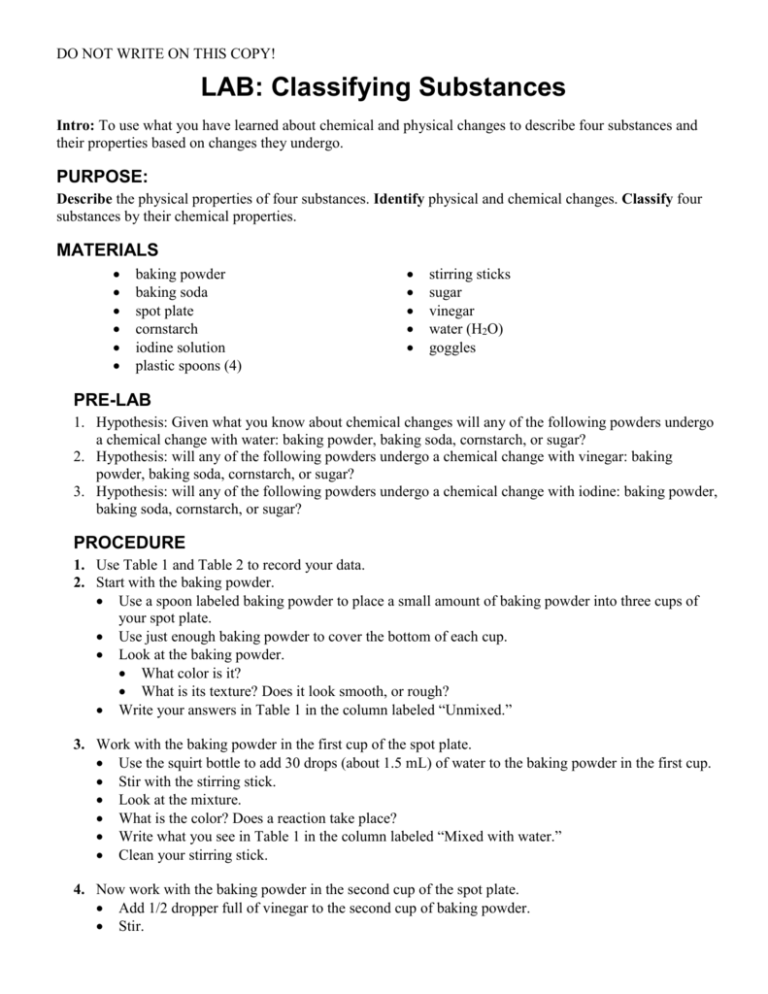
DO NOT WRITE ON THIS COPY! LAB: Classifying Substances Intro: To use what you have learned about chemical and physical changes to describe four substances and their properties based on changes they undergo. PURPOSE: Describe the physical properties of four substances. Identify physical and chemical changes. Classify four substances by their chemical properties. MATERIALS baking powder baking soda spot plate cornstarch iodine solution plastic spoons (4) stirring sticks sugar vinegar water (H2O) goggles PRE-LAB 1. Hypothesis: Given what you know about chemical changes will any of the following powders undergo a chemical change with water: baking powder, baking soda, cornstarch, or sugar? 2. Hypothesis: will any of the following powders undergo a chemical change with vinegar: baking powder, baking soda, cornstarch, or sugar? 3. Hypothesis: will any of the following powders undergo a chemical change with iodine: baking powder, baking soda, cornstarch, or sugar? PROCEDURE 1. Use Table 1 and Table 2 to record your data. 2. Start with the baking powder. Use a spoon labeled baking powder to place a small amount of baking powder into three cups of your spot plate. Use just enough baking powder to cover the bottom of each cup. Look at the baking powder. What color is it? What is its texture? Does it look smooth, or rough? Write your answers in Table 1 in the column labeled “Unmixed.” 3. Work with the baking powder in the first cup of the spot plate. Use the squirt bottle to add 30 drops (about 1.5 mL) of water to the baking powder in the first cup. Stir with the stirring stick. Look at the mixture. What is the color? Does a reaction take place? Write what you see in Table 1 in the column labeled “Mixed with water.” Clean your stirring stick. 4. Now work with the baking powder in the second cup of the spot plate. Add 1/2 dropper full of vinegar to the second cup of baking powder. Stir. DO NOT WRITE ON THIS COPY! Write what you see in Table 1 in the column labeled “Mixed with vinegar.” Clean your stirring stick. 5. Next, work with the baking powder in the third cup of the spot plate. Add 5 drops of iodine solution to the third cup of baking powder. Caution: Be careful when using iodine. Iodine will stain your skin and clothes. Stir. Write what you see in Table 1 in the column labeled “Mixed with iodine solution.” Clean your stirring rod. Table 1 Observations Substance Baking powder Baking soda Cornstarch Sugar Unmixed Mixed with water Mixed with vinegar Mixed with iodine solution 6. Repeat steps 2–5 for each of the other substances (baking soda, cornstarch, and sugar). Use a clean spoon with the correct label for each substance. 7. Analyzing Data In Table 2, write down the following for each substance: The type of change you saw—physical or chemical The property that the change demonstrates—reactivity or solubility Table 2 Changes and Properties Substance Baking powder Baking soda Cornstarch Sugar Mixed with iodine Mixed with water Mixed with vinegar solution Change Property Change Property Change Property ANALYSIS QUESTIONS 1. Making Predictions Suppose that you have a mixture of two substances. a. The mixture turns black when it is mixed with iodine and bubbles when it is mixed with water and vinegar. b. What two substances are in the mixture? (Hint: Use two of the substances from this experiment.) 2. Drawing Conclusions Reactivity is a chemical property. Tell which liquid each of the four substances reacted with, if any. Explain how you know that there was a chemical reaction. What is the difference between a chemical change and a physical change?
